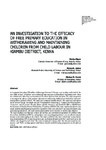An investigation to the efficacy of free primary education in withdrawing and maintaining children from child labour in Kiambu district, Kenya

View/
Date
2011Author
Ngao, Gladys
Julius, Maiyo K.
David, Mulwa M.
Metadata
Show full item recordAbstract
It is estimated that about 250 million children aged between 5-14 years were working world wide by the year 2006, at least 120 million were working full time and close to 80 million in hazardous work. These are children who either have no education at all or have had very little education. The study was geared to investigate the efficacy of free primary education in withdrawing children from child labour and main-taining them in primary schools. The study was conducted Kiambu district. The study used descriptive survey research design, the sample size was 70 respondents comprising of:32 pupils, four head teachers, 16 teachers, and 16 parents, Kiambu District Quality Assurance and Standards Officer (DQASO)and the Secretary of Kiambu District Child Labour Committee (SDCLC).The study employed purposive and simple random sampling design to pick the respondents. Data was collected by use of questionnaires and focused group discussion. The study employed descriptive survey statistics to analyze data obtained.The major findings were that most schools did not have any orientation programmes for children with-drawn from child labour (CWCLs), and guidance and counseling programmes were not effective mainly because of the understaffing in the schools. The study established that most schools had various limita-tions in maintaining CWCLs and did not have any mechanism through which they could reach out to the children who dropped out of school. The study recommended among others that the government in con-junction with NGOs working against child labour should establish feeding programmes in the affected schools
Collections
- School of Education [203]
